| Intro Geologic Background | Text: Legal Issues | Images: Fossil Plants | Images: Lignite (Coal) |
| Images: Trace Fossils | Images: Days Of Discovery | Images: Field Trip 10-19-1999 | Images: Field Trip 8-19-2000 |
| Images: Field Trip Summer 2002 | Images: Field Trip 10-14-2002 | Images: Field Trip 10-22-2002 | Images: Field Trip 10/25-27/2002 |
| Images: Field Trip 6-3-2003 | Images: Field Trip 3-8-2004 | Images: Field Trip 3-11-2004 | Widget: Ione Weather |
| Links: My Music Pages | Links: My Fossils Pages | Links: USGS Papers | Email Address |
|
I've created this Web Page with a two-fold purpose--first, of course, to document my own personal, on-going actitivies and studies in the Middle Eocene Ione Formation (roughly 49 to 45 million years old) of the Ione Basin, Amador County, California. Then too, I hope that what I have to publish here will perhaps in some small measure help generate, among folks in cyberspace, a wider interest in the paleobotany, botany, geology and general natural history of that specific section of Amador County. Because it is my own humble, subjective opinion that this is a topic brim-full of fascinating, stimulating things to study. Ever since I discovered Eocene-age fossil leaves in the Ione Basin on July 21, 1991, I've been hooked big-time, as it were, and my personal quest to learn all that I can has inspired many hikes through ancient geologic rock exposures that have yielded, in several rather unexpected places, bountiful, beautiful Eocene fossil leaves amidst the pastoral peace of the western foothills of California's Sierra Nevada. Perhaps a little background information is now in order. After having discovered numerous prolific fossil leaf localities in the Middle Eocene Ione Formation during occasional visits in the early to mid 1990s--paleobotanical localities that were new to science--I soon found myself traveling to the Ione Basin on a more regular, scientifically motivated basis. These were usually weekend trips to the Sierran foothills of Amador County to try to collect from--and of course document--as many of my newly found fossil leaf localities as possible. To the best of my knowledge, nobody had ever really tried to do this in a systematic manner. True, one or two geologists had already noted the presence of "a few scattered" leaf fossils in the Ione Formation of the Ione Basin, but no one had ever seriously tried to collect specimens there, and then study them--and, additionally, try to plot their occurrences on a topographic map. From the very beginning, the Eocene Ione Formation Project was a veritable "labor of love." Images from a number of those early excursions to the Ione fossil fields can be found in the section entitled, Days Of Discovery. My own participation in the project came to an even sharper scientific focus when in late 1998 I donated my many extensive collections of fossil plants from the Ione Formation, Ione Basin, to the archival paleobotany collections at the University California Museum Of Paleontology. As far as I am aware, those were the very first fossil plants from the Middle Eocene Ione Formation of the Ione Basin ever placed in a museum. That donation led to a field trip to the Ione Basin with paleobotanists Howard Schorn (retired Collections Manager Of Fossil Plants at the University California Museum Of Paleontology) and Dr. Diane Erwin (Collections Manager Of Fossil Plants at UCMP)--a field trip documented at this Web Page under the heading--Field Trip 10-19-99. Another major highlight came in July-August, 2002, when I was privileged to help Howard Schorn conduct the first formal, scientific museum-sponsored collection of fossil leaves from the Ione Formation of the Ione Basin. See the Field Trip Summer 2002 section of this Web site for all the details. More recently, Howard Schorn and fellow paleobotanist Dr. Jack A. Wolfe (update: Howard Schorn passed in 2013; and Jack Wolf passed away in 2005--former member of the United States Geological Survey), among others, hope to use suites of fossil leaves from the Ione Formation of the Ione Basin to help determine the paleoelevations and paleoclimate of the ancestral Eocene Sierra Nevada. This is part of a broader project, funded by the National Science Foundation, to analyze the numerous Eocene fossil floras of the Sierra Nevada district, to run the fossil leaves through Dr. Wolfe's famous CLAMP analysis--Climate Leaf Analysis Multivariate Program. The system is an accurate methodology that uses the relative size, shape and margins of fossil leaves to arrive at the paleoelevations and paleoclimates of specific fossil floras. The idea, eventually, is to determine, once and for all, just how high the ancestral Eocene Sierra Nevada really was. Several super-field trips have since followed. And they're all fully documented, below. Of course, this is all an on-going, developing storyline. The Ione Basin fossil floras are pretty much new to the paleobotanical community--hence, it is understandable that they have not yet been described in comprehensive, monographic detail. A few of the fossil forms are of course readily identifiable, even under casual inspection--the fan palm fronds, for example, plus the distinctive leaves from a species of climbing fern called Lygodium kaulfussi, whose closest modern counterpart is Lygodium palmatum--the sole species of climbing fern native to North America; it's been spotted in Missississipi, Alabama and Georgia north to New England. Interestingly enough, rather common to abundant specimens of Lydodium kaulfussi have been collected from a single locality in the Ione Formation of the Ione Basin; it's a spot I discovered during one of my paleobotantical investigations in 1992--a supremely prolific site known, appropriately enough, as Lygodium Gulch. And, as a matter of fact, the Lygodium remains recovered from the Ione Basin are the only known fossil climbing ferns found west of the Rocky Mountains region to make their way into a museum collection (at the University California Museum Of Paleontology). This is mainly because localities that yield fossil climbing ferns are quite rare, indeed--the major producers of Lygodium in the United States remain the Middle Eocene Green River Formation and the middle to Upper Eocene Bridger Formation of Colorado Wyoming, and Utah. Of course, with time, paleobotanists will eventually identify and describe in great scientific detail the fossil floras of the Ione Basin--so, as the saying goes, "stay tuned" for more information--The Project continues. |
|
The Ione Basin lies within Amador County and northern Calaveras County in the western foothills of California's Sierra Nevada. It's a scenic and economically important geophysical province roughly 30 miles long by four to seven miles wide whose primary surface exposures of Cenozoic sedimentary rocks include the middle Miocene Mehrten Formation, the Oligocene to lower Miocene Valley Springs Formation, and what geologists and stratigraphers alike call the middle Eocene Ione Formation (around 49 to 45 million years old); indeed, the Ione is a most-famous geologic rock unit that yields world-renowned commercial deposits of extraordinarily pure silica sand and high-grade kaolinite clays--in addition to extensive accumulations of the rare and valuable Montan Wax-rich lignite, which is mined commercially at only two places in the world--the other Montan Wax site is in Germany; lignite is classified as a type of low-grade coal whose alteration of original vegetation has proceeded further than in peat, but obviously not as great as anthracite coal. Montan Wax occurs quite rarely in the geologic record when the waxy substance which once protected the original plant leaves from extremes of climate did not deteriorate, but instead enriched the coal. Commercial applications for Montan Wax include polish, carbon paper, road construction, building, rubber, lubricating greases, fruit coating, water proofing and leather finishing. All of these mineral commodities--silica sands, kaolinite clays and Montan Wax-yielding liginites--have been mined in the Ione Basin by open-pit methods for many decades. As a matter of fact, today the Ione Basin lignites remain California's only actively mined coal resources. Geologically speaking, the Ione Formation in the Ione Basin was deposited in floodplains, estuaries, lagoons, deltas, mashes-swamps, and marine waters (based on extraordinarily rare occurrences of unquestioned marine mollusks) along the eastern shores of a vast inland sea during middle Eocene times--a sea that had flooded, transgressed, what is now California's Great Central Valley during the early portions of the Eocene, approximately 53 million years ago; but, in a curious display of geological marine cyclicity, sea waters had actually receded, regressed, from the vicinity of the ancestral Ione Basin many millions of years earlier, specifically during the early Tertiary Period, roughly 60 million years ago. For approximately seven million succeeding years, through most of the Paleocene Epoch of the Cenozoic Era, the area now recognized as the western foothills of the Sierra Nevada, Amador County, California, was left "high and dry," exposed directly to an unrelenting hot, humid tropical environment that left behind distinctive deposits of laterite--which is an iron and aluminum-rich deep-red soil zone that forms today only in tropical environments capable of leaching away soluble minerals (feldspar, biotite and chlorite, among others), clays (kaolinite, illite and montmorillonite) and silica--places such as India, for example, that experience cycles of hot-dry winters combined with monsoon tropical rainfall, high humidity and extreme temperatures. When marine waters began to encroach once again throughout the ancestral Central Valley during early Eocene times, the prevailing climate had already become less severely tropical than the environment that helped create the laterite soil profiles--although most scientists agree that conditions would still be classified as subtropical--that is, quite hot and humid, with frequent, substantial amounts of precipitation. Now, with sea waters rising again in the neighborhood of present-day Ione Basin--transgressing, as geologists describe the process--the numerous rivers and streams whose sources existed in the ancestral Eocene Sierra Nevada to the immediate east began to "back up;" gradients slackened; and the rivers proceeded to wander in great braided, anastomozing courses along the floodplains. Deposition of the middle Eocene Ione Formation had begun. Those rocks deposited earliest in the local Ione geologic section (hence, they are the oldest)--strata that have proved the most amenable to commercial mining--typically consist of reddish-brown-colored kaolinite-rich clays and shales, brilliant white quartz (silica)-dominated sandstones, and dull-brownish to black-hued Montan-Wax-bearing lignites that accumulated in a semi-tropical climate of rather intense chemical and physical weathering--a process that leached away all but the more-resistant mineral constituents--quartz and kaolinite clay. Probably the paleoclimate resembled modern-day southern Florida in the southeastern United States. Occasionally, lignite miners in the Ione Basin report finding huge fossil logs buried with the more massive-beds of fossil peat. Higher in the Ione section, in rocks of younger geologic age, the exposed clays, sandstones and shales bear a greater percentage of feldspar, biotite and chlorite. Such a dramatic change in mineral composition signifies a major shift in paleoclimate during middle Eocene times. Although conditions during deposition of the younger Ione sediments were still dominated by extreme humidity, high rainfall and warm semi-tropical temperatures, the once-rigorous climatic regime of intense weathering had subsided considerably and a general cooling trend began to prevail. It was within these younger sedimentary rocks of the Ione Formation that the paleobotanically invaluable suites of fossil leaves were preserved. Approximately 49 to 45 million years ago, on occasion, the great system of braided rivers that ran to the inland sea became engorged and overran their banks, resulting in episodes of widespread catastrophic flooding. The high-energy rushing waters carried with them enormous quantities of fine-grained sediments, plus abundant leaves torn from the plants that inhabited the watercourses along the wide alluvial floodplains. When flooding eventually subsided, many of the leaves that had been swept along for the ride became winnowed, concentrated, in overbank backwater pools and within the many broad alluvial mudflats, having been covered rapidly by feldspar and quartz-rich sediments eroding from the ancestral Sierra Nevada. There, the leaves remained protected between muddy, oxygen-depleted sedimentary layers, vegetable tissues that were impervious to immediate decay due to the high water table along the Eocene floodplain. Eventually, geologic forces lithified--that is, hardened--the plant-bearing ooze, preserving within, in stunning detail, the numerous fossil leaves now stained a striking reddish brown (due to the presence of iron minerals) on the brilliant white shales and reddish-brown sandstones of the Ione Formation--abundant Eocene leaves only awaiting eager fossil seekers to reveal them to their first light of day in some 45 million years. Indeed, here is one of the great fossil leaf-bearing districts in all of California--an extensive fossil field which is at last providing paleobotanists with their first detailed look at the kinds of ancient plants that inhabited an essentially sea-level floodplain paleoenvironment along the western border of the ancestral Sierra Nevada mountains approximately 49 to 45 million years ago. It is an as-yet completely undescribed fossil flora, relatively new to science--but one that will surely provide lots of invaluable scientific information on the paleobotany of the ancient Ione Basin. |
|
OK, here's the part of this Web Site that I really dislike having to include, but it's a necessary thing to do in this particular instance. Let's talk about legal issues regarding fossil collecting activities in the western foothills of the Sierra Nevada, California--the specific regions discussed here where fossil plants occur in the Ione Basin of Amador County...I know, I know, in an ideal world, most paleontology enthusiasts would rather not have to worry about such dreary and distracting concerns. We'd rather roam the countryside for fossiliferous outcrops without having to fret about whether we need permission to collect fossils at any given locality. So, without any additional "fanfare," let's explore the legalities of collecting fossils in the areas discussed at this Web Site: First of all, every fossil plant locality mentioned here is completely off limits to unauthorized fossil collecting. In the western foothills of the Sierra Nevada, each recently discovered paleobotanical site in the Middle Eocene Ione Formation, Amador County, California, occurs on private property; one needs explicit permission from the land owners in order to collect fossil plants in the Ione Formation. That same edict also holds true for all the other fossil plant-yielding sites in the western foothills of the Sierra Nevada--they're all off-limits if you don't have permission from the land owners. There's no use belaboring the fact, I reckon. That's just the way reality works in the western foothills of the Sierra Nevada, California. |
|
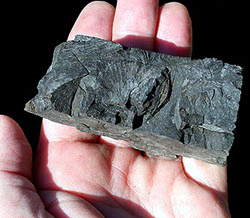 |
Click on the image for a larger image. This is a chunk of high-grade, Montan Wax-bearing lignite from the Middle Eocene Ione Formation, Ione Basin, western foothills of the Sierra Nevada, California. It came from the walls of California's only active coal mine, where lignites bearing the rare Montan Wax have been mined for several decades now. Only two places in the world produce commercially minable deposits of Montan Wax--the Ione Basin, California, and Amsdorf, Germany. Lignite from the Middle Eocene Ione Formation of the Ione Basin is a low-grade coal which has not been subjected to great forces of heat and pressure through geologic time--hence, the waxy substance of the original vegetal constituents has not been obliterated, or altered. Montan Wax occurs quite rarely in the geologic record when the waxy substance which once protected the original plant leaves from extremes of climate did not deteriorate, but instead enriched the coal. Commercial applications for Montan Wax include polish, carbon paper, road construction, building, rubber, lubricating greases, fruit coating, water proofing and leather finishing. |
|
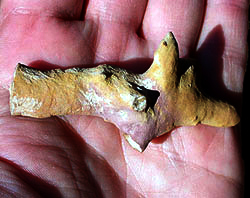 |
Click on the image for a larger view. This is an ichnofossil (trace fossil), called scientifically Ophiomorpha, from the Middle Eocene Ione Formation, western foothills of the Sierra Nevada. It is the fossilized burrow of a species of shrimp-like animal, most likely a callianassid shrimp. Here is a comprehensive description of just what Ophiomorpha represents from the web page at http://www.envs.emory.edu/ichnology/Ophiomorpha.htm: "Ophiomorpha is a branching burrow with either horizontal, oblique, or vertical box-like networks; the burrow exterior is characterized by a knobby texture formed by a pelletal lining, but in some cases only an internal mold of the burrow is evident. Ophiomorpha is interpreted as a combined dwelling and feeding burrow made by a shrimp-like animal; modern callianassid shrimp show the same burrow geometry and pelletal reinforcement of their burrows." |
|
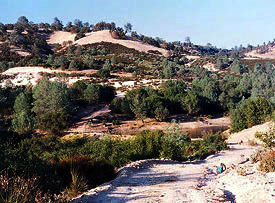 |
Click on the image for a larger view. Here is a late afternoon view to the Discovery Site in the Ione Basin, Amador County, California--the specific locality, marked by the blue backpack at lower right, where I first found fossil plants in the Middle Eocene Ione Formation on July 21, 1991. This is pretty high up in the local Ione Formation geologic section. Take a look at the pale-brown, brush covered slopes along the skyline. The overlying Upper Oligocene to Lower Miocene Valley Springs Formation begins at the dramatic, distinctive vegetation break along that hillside in the distance--the exact geologic contact between the Valley Springs above and the Ione Formation below lies at the obvious break between the green manzanita brush below and the pale-brown, grass-covered, tree-studded slope above; rocks above the patch of green manzanita, to the skyline, belong to the Valley Springs Formation. What follows is a series of images depicting several of the original fossil leaf localities I discovered in the Ione Basin during my "Days Of Discovery"-- my periodic explorations--in the Middle Eocene Ione Formation. |
|
|
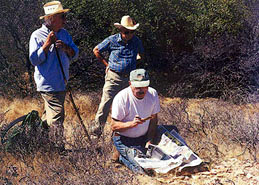 |
Click on the image for a larger view. This is a photograph snapped on August 19, 2000, at famous Lygodium Gulch in the Middle Eocene Ione Formation, Ione Basin. The late paleobotanist Dr. Jack A. Wolfe is kneeling, examining a fossil leaf specimen before he wraps it in newspaper for safe transport to the archival paleobotanical collections at the University California Museum Of Paleontology in Berkeley. My late father, an Engineering Geologist, looks on in the blue plaid shirt behind Dr. Wolfe, while paleobotanist Howard Schorn (with the walking stick in hand), gazes to the scenic countryside all around us. To help professional paleobotanists prepare for their proposed project to study the numerous Eocene fossil floras of the Sierra Nevada region, to determine the paleoelevations and paleoclimate of the ancestral Sierra Nevada roughly 50 to 45 million years ago, my father (an Engineering Geologist) and I took paleobotanists Howard Schorn, Dr. Jack A. Wolfe and Dr. Bruce Tiffney on a day's tour of some significant fossil leaf localities in the Ione Basin. Images from the visit follow. |
|
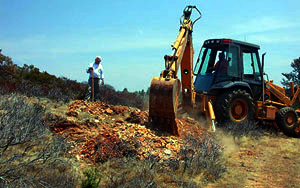 |
Click on the image for a larger view. Paleobotanist Howard Schorn (retired Collections Manager Of Fossil Plants at the University California Museum Of Paleontology in Berkeley) supervises a backhoe operator at a famous fossil plant locality, Lygodium Gulch. The backhoe operator is exposing for ease of collecting a trench at the primary fossil horizon. Image taken on July 30, 2002. A proposed National Science Foundation grant to study the Eocene fossil floras of California's Sierra Nevada region had finally been approved. This was unexpected, but wondrously exciting news, indeed. Only a year earlier, I had learned that the NSF project had been denied by the "powers that be," as it were. Now, Howard Scborn invited me to accompany him to Lygodium Gulch, the most prolific and easily accessible fossil plant locality in the Ione Basin, to spend a week collecting leaf fossils for the NSF study. Images from the field trip follow. |
|
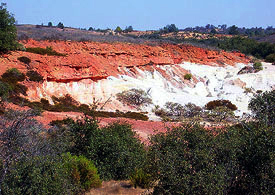 |
Click on the image for a larger view. This is a classic, scenically striking geologic contact in the Middle Eocene Ione Formation, western foothills of the Sierra Nevada, Ione Basin, Amador County, California. The whitish layer in the exposure is a massive, coarse sandstone that represents turbulent floodplain conditions some 48 million years ago during Eocene geologic times. Above that massive white sandstone is a more thinly bedded deposit of feldspar-rich reddish-brown sandstones and shales; probably this too was deposited by rivers that periodically flooded their banks, but the mineral contact of the shales and sandstones is dramatically different than the essentially pure quartz content of the massive white sandstone below. Picture taken October 14, 2002. I had long-wanted to get father, an Engineering Geologist, out to Lygodium Gulch, to observe first-hand the stratigraphy and geology of the area after paleobotanist Howard Schorn and I had quarried the fossil locality earlier that year, in late July and early August of 2002. Also, I wanted to take some photographs of the local flora. Images from that October 14, 2002, visit follow. |
|
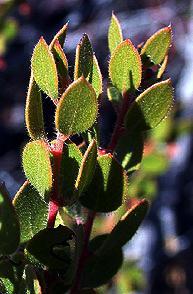 |
Click on the image for a larger picture. Close-up of the foliage of the rare, protected Ione manzanita, Arctostaphylos myrtifolia, observed near the famous Lygodium Gulch fossil leaf locality in the Middle Eocene Ione Formation. The Ione manzanita grows nowhere else on Earth in the wild, save on the extraordinarily harsh, acidic soils weathered from the Eocene Ione Formation within the unique Ione Chaparral botanic association, Ione Basin, Amador County, California. Image snapped on October 22, 2002. In preparation for a field trip with paleobotanist Howard Schorn and student crews from a Community College and a university, scheduled for October 25-27, 2002, I wanted to return to Lygodium Gulch to clear entangled brush from the path to the fossil locality. Also, I wanted to snap some photographs of the two dominant, local species of manzanitas. Images from that visit on October 22, 2002, follow. |
|
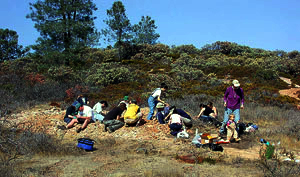 |
Click on the image for a larger view. Students from a Community College and a university help collect fossil leaves from the Middle Eocene Ione Formation at famous Lygodium Gulch during a weekend field trip to the Ione Basin, western foothills of the Sierra Nevada, Amador County, California. The combined student forces helped increase the numbers of fossil leaves available for a fascinating paleobotanical project sponsored by the National Science Foundation--to study the Eocene floras of the Sierra Nevada district, in order to determine the paleoelevations and paleoclimate of the ancestral Eocene Sierra Nevada. Image taken on October 27, 2002. Images from the field trip with the combined College-university collecting crews on October 25-27, 2002, follow. |
|
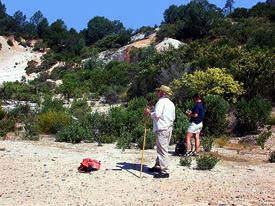 |
Click on the image for a larger picture. Paleobotanist Howard Schorn, retired Collections Manager Of Fossil Plants at the University California Museum Of Paleontology in Berkeley, and geologist Robinson Cecil observe significant outcrops of the Middle Eocene Ione Formation in the Ione Basin, western foothills of the Sierra Nevada, Amador County, California. Image snapped on June 3, 2003. Howard had invited me on the field trip to help Robinson, then a geology student at the University Of Arizona in Tucson, familiarize herself with some leaf-bearing Eocene geologic sections she planned to measure for a National Science Foundation project (co-led by the late paleobotanist Dr. Jack A. Wolfe) to determine the paleoelevations and paleoclimate of the Sierra Nevada during Eocene geologic times, roughly 50 to 45 million years ago. Images from that visit on June 3, 2003, follow. |
|
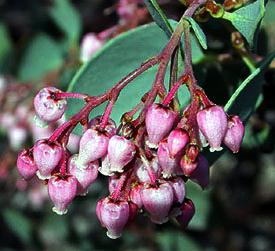 |
Click on the image for a larger picture. Close-up of pinkish flowers on the Sticky white-leaf manzanita, Arctostaphylos viscida, growing in the vicinity of Lygodium Gulch, a classic fossil leaf locality in the Middle Eocene Ione Formation, Ione Basin, western foothills of the Sierra Nevada, Amador County, California. Image snapped on March 8, 2004. In early March, 2004, I had heard news reports that the manzanita blooms in the western foothills of the Sierra Nevada were especially abundant. That was quite an enticement all by itself, of course. Also, it was undeniably obvious that I had not visited the Ione Basin in roughly 9 months, not since the fabulous field trip on June 3, 2003, with paleobotanist Howard Schorn and geologist Robinson Cecil. Needless to report, I was itching to return to the Ione Basin. For my day's visit on March 8, 2004, I planned to document not only the manzanita blooms in the vicinity of famous Lygodium Gulch, probably the most prolific and accessible of the great fossil leaf localities in the Middle Eocene Ione Formation of the Ione Basin, but also a few of the other fossiliferous sites in the immediate area, as well. Images from that visit on March 8, 2004, follow. |
|
 |
Click on the image for a larger picture. Exposures of the Middle Eocene Ione Formation in the vicinity of the Discovery Site--so-named because that's where I first found fossil plants in the Ione Basin on July 21, 1991. Grayish-white, unfossiliferous carbonaceous mudstones outcrop below plant-bearing reddish-brown sandstones (roughly middle of picture). At upper left to upper-center, the grass-covered, tree-studded slopes belong to overlying Lower Miocene Valley Springs Formation. Image taken on March 11, 2004. After my enjoyable day's return to the Ione Basin on May 8, 2004, while the weather still held, I wanted to revisit the vicinity of The Discovery site, to document outcrops of the Middle Eocene Ione Formation. Several of the exposures out that way yielded common to abundant fossil leaves--fossilferous horizons I wanted to examine and photograph, naturally--but, in addition, I also had in mind to document with a camera a number of the representative rock lithologies of the Middle Eocene Ione Formation. Images from that visit on March 11, 2004, follow. |
|

|